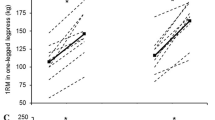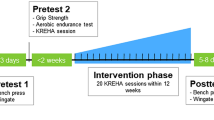Abstract
This study examined supramaximal cycling performed to exhaustion at 120% of peak O2 uptake (120% VO2peak) before and after 8 weeks of strength training. Eight previously untrained men completed 8 weeks of leg-strength training 3 days week−1 on a hack-squat machine; four sets, five repetitions at 85% of one repetition maximum each session. Anaerobic capacity was quantified by determining the maximal accumulated O2 deficit during supramaximal cycling. After 8 weeks of strength training, one repetition maximum for the hack squat significantly increased by 90 ± 33% when compared to before training. However, 8 weeks of strength training did not increase the maximal accumulated O2 deficit. Nevertheless, after 8 weeks of strength training, there was a significant increase in time to exhaustion for cycling at 120% VO2peak. The increase in time to exhaustion after 8 weeks of strength training was accompanied by a significant increase in accumulated O2 uptake. In conclusion, 8 weeks of strength training improves supramaximal cycling performance in previously untrained subjects. However, increases in time to exhaustion for supramaximal cycling following strength training are associated with an increase in the contribution of the aerobic energy system rather than an improvement in anaerobic capacity.

Similar content being viewed by others
References
Abernethy PJ, Jurimae J, Logan PA, Taylor AW, Thayer RE (1994) Acute and chronic response of skeletal muscle to resistance exercise. Sports Med 17:22–38
Chromiak JA, Smedley B, Carpenter W, Brown R, Koh YS, Lamberth JG, Joe LA, Abadie BR, Altorfer G (2004) Effect of a 10-week strength training program and recovery drink on body composition, muscular strength and endurance, and anaerobic power and capacity. Nutrition 20:420–427
Durnin J., Womersley J (1974) Body fat assessed from total body density and its estimation from skinfold thickness: measurements on 481 men and women aged from 16 to 72 years. Br J Nutr 32:77–97
Fatouros IG, Kambas A, Katrabasas I, Nikolaidis K, Chatzinikolaou A, Leontsini D, Taxildaris K (2005) Strength training and detraining effects on muscular strength, anaerobic power, and mobility of inactive older men are intensity dependent. Br J Sports Med 39:776–780
Fukuoka Y, Grassi B, Conti M, Guiducci D, Sutti M, Marconi C, Cerretelli P (2002) Early effects of exercise training on on- and off-kinetics in 50-year-old subjects. Pflugers Arch 443:690–697
Häkkinen K, Kauhanen H, Komi PV (1987) Aerobic, anaerobic, assistant exercise and weightlifting performance capacities in elite weightlifters. J Sports Med Phys Fitness 27:240–246
Inbar O, Bar-Or O, Skinner JS (1996) The Wingate Anaerobic Test. Human Kinetics, Champaign, pp 381–394
Loveless D, Weber C, Haseler L, Schneider D (2005) Maximal leg-strength training improves cycling economy in previously untrained men. Med Sci Sports Exerc 37:1231–1236
MacDougall JD, Ward GR, Sale DG, Sutton JR (1977) Biochemical adaptation of human skeletal muscle to heavy resistance training and immobilization. J Appl Physiol 43:700–703
Maestu J, Jurimae J, Jurimae T (2005) Monitoring of performance and training in rowing. Sports Med 35:597–617
Marcinik E, Potts J, Schlabach G, Will S, Dawson P, Hurley B (1991) Effects of strength training on lactate threshold and endurance performance. Med Sci Sports Exerc 23:139–143
Medbø JI, Tabata I (1989) Relative importance of aerobic and anaerobic energy release during short-lasting exhausting bicycle exercise. J Appl Physiol 67:881–886
Medbø JI, Burgers S (1990) Effect of training on the anaerobic capacity. Med Sci Sports Exerc 22:501–507
Medbø JI, Tabata I (1993) Anaerobic energy release in working muscle during 30 s to 3 min of exhausting cycling. J Appl Physiol 74:1654–1660
Medbø JI, Mohn AC, Tabata I, Bahr R, Vaage O, Sejersted OM (1988) Anaerobic capacity determined by maximal accumulated oxygen deficit. J Appl Physiol 64:50–60
Minahan CL, Chia M, Inbar O (2007) Does power indicate capacity? 30-s Wingate Anaerobic Test vs. maximal accumulated O2 deficit. Int J Sports Med (in press)
Østerås HJ, Helgerud J, Hoff J (2002) Maximal strength training effects of force-velocity and force-power relationships explain increases in aerobic performance in humans. Eur J Appl Physiol 88:255–263
Pizza FX, Naglieri TA, Holtz RW, Mitchell JB, Starling RD, Phillips MD, Cavender DL, Braun WA (1996) Maximal accumulated oxygen deficit of resistance-trained men. Can J Appl Physiol 21:391–402
Pringle JSM, Doust JH, Carter H, Tolfrey K, Campbell IT, Jones AM (2003) Oxygen uptake kinetics during moderate, heavy and severe intensity ‘submaximal’ exercise in humans: the influence of muscle fibre type and capillarisation. Eur J Appl Physiol 89:289–300
Saltin B (1987) The physiological and biochemical basis of aerobic and anaerobic capacities in man: effect of training and range of adaptation. In: Mæhlum S, Nilsson A, Renström P (eds) An update of sports medicine. Proceedings from the second Scandinavian Conference in Sports Medicine. Oslo, Norway, pp 16–59
Sharp RL, Costill DL, Fink WJ, King DS (1986) Effects of eight weeks of bicycle ergometer sprint training on human muscle buffer capacity. Int J Sports Med 7:13–17
Slade JM, Miszko TA, Laity JH, Agrawal SK, Cress ME (2002) Anaerobic power and physical function in strength-trained and non-strength-trained older adults. J Gerontol Biol Sci Med Sci 57:M168–172
Tesch PA, Komi PV, Hakkinen K (1987) Enzymatic adaptations consequent to long-term strength training. Int J Sports Med 8(Suppl 1):66–69
Thorstensson A, Hulten B, von Dobeln W, Karlsson J (1976) Effect of strength training on enzyme activities and fibre characteristics in human skeletal muscle. Acta Physiol Scand 96:392–398
Weber C, Schneider D (2001) Reliability of MAOD measured at 110% and 120% of peak oxygen uptake for cycling. Med Sci Sports Exerc 33:1056–1059
Weber C, Schneider D (2002) Increases in maximal accumulated oxygen deficit after high-intensity interval training are not gender dependent. J Appl Physiol 92:1795–1801
Weber CL, Chia M, Inbar O (2006) Gender differences in anaerobic power of the arms and legs—a scaling issue. Med Sci Sports Exerc 38:129–137
Weyand PG, Cureton KJ, Conley DS, Higbie EJ (1993) Peak oxygen deficit during one-and two-legged cycling in men and women. Med Sci Sports Exerc 25:584–591
Withers RT, Van der Ploeg G, Finn JP (1993) Oxygen deficits incurred during 45, 60, 75 and 90-s maximal cycling on an air-braked ergometer. Eur J Appl Physiol Occup Physiol 67:185–191
Author information
Authors and Affiliations
Corresponding author
Rights and permissions
About this article
Cite this article
Minahan, C., Wood, C. Strength training improves supramaximal cycling but not anaerobic capacity. Eur J Appl Physiol 102, 659–666 (2008). https://doi.org/10.1007/s00421-007-0641-2
Accepted:
Published:
Issue Date:
DOI: https://doi.org/10.1007/s00421-007-0641-2




